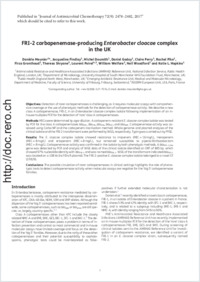FRI-2 carbapenemase-producing Enterobacter cloacae complex in the UK
- Meunier, Danièle Antimicrobial Resistance and Healthcare Associated Infections (AMRHAI) Reference Unit, National Infection Service, Public Health, England, London, UK
- Findlay, Jacqueline Antimicrobial Resistance and Healthcare Associated Infections (AMRHAI) Reference Unit, National Infection Service, Public Health, England, London, UK
- Doumith, Michel Antimicrobial Resistance and Healthcare Associated Infections (AMRHAI) Reference Unit, National Infection Service, Public Health, England, London, UK
- Godoy, Daniel Antimicrobial Resistance and Healthcare Associated Infections (AMRHAI) Reference Unit, National Infection Service, Public Health, England, London, UK
- Perry, Claire Antimicrobial Resistance and Healthcare Associated Infections (AMRHAI) Reference Unit, National Infection Service, Public Health, England, London, UK
- Pike, Rachel Antimicrobial Resistance and Healthcare Associated Infections (AMRHAI) Reference Unit, National Infection Service, Public Health, England, London, UK
- Gronthoud, Firza Department of Microbiology, University Hospital of South Manchester NHS Foundation Trust, Manchester, UK
- Shryane, Theresa Public Health England North West, Manchester, UK
- Poirel, Laurent Emerging Antibiotic Resistance Unit, Medical and Molecular Microbiology, Department of Medicine, Faculty of Science, University of Fribourg, Switzerland - INSERM European Unit, LEA, Paris, France
- Welfare, William Public Health England North West, Manchester, UK
- Woodford, Neil Antimicrobial Resistance and Healthcare Associated Infections (AMRHAI) Reference Unit, National Infection Service, Public Health, England, London, UK
- Hopkins, Katie L. Antimicrobial Resistance and Healthcare Associated Infections (AMRHAI) Reference Unit, National Infection Service, Public Health, England, London, UK
-
01.09.2017
Published in:
- Journal of Antimicrobial Chemotherapy. - 2017, vol. 72, no. 9, p. 2478–2482
English
Objectives: Detection of rarer carbapenemases is challenging, as it requires molecular assays with comprehensive coverage or the use of phenotypic methods for the detection of carbapenemase activity. We describe a new class A carbapenemase, FRI-2, in an Enterobacter cloacae complex isolate following implementation of an in- house multiplex PCR for the detection of ‘rare’ class A carbapenemases.Methods: MICs were determined by agar dilution. A carbapenem-resistant E. cloacae complex isolate was tested by PCR for the class A carbapenemases blaKPC, blaFRI, blaIMI, blaGES and blaSME. Carbapenemase activity was assessed using Carba NP and the carbapenem inactivation method. Whole genome and plasmid analyses of the clinical isolate and the FRI-2 transformant were performed by WGS, respectively. Typing was carried out by PFGE.Results: The E. cloacae complex isolate showed resistance to imipenem (MIC = 16 mg/L), meropenem (MIC = 8 mg/L) and ertapenem (MIC = 8 mg/L), but remained susceptible to piperacillin/tazobactam (MIC = 8 mg/L). Carbapenemase activity was confirmed in the isolate by both phenotypic methods. A blaFRI-1-like gene was detected by PCR and analysis of WGS data of the clinical isolate identified an ORF of 885 bp, which showed 97% nucleotide identity with blaFRI-1 and was named blaFRI-2. WGS of the transformant indicated blaFRI-2 was located on a 108 kb IncF/IncR plasmid. The FRI-2-positive E. cloacae complex isolate belonged to a novel ST (ST829).ConclusionsThe possible circulation of rarer carbapenemases in clinical settings highlights the role of phenotypic tests to detect carbapenemase activity when molecular assays are negative for the ‘big 5’ carbapenemase families.
- Faculty
- Faculté des sciences et de médecine
- Department
- Médecine 3ème année
- Language
-
- English
- Classification
- Biological sciences
- License
-
License undefined
- Identifiers
-
- RERO DOC 305754
- DOI 10.1093/jac/dkx173
- Persistent URL
- https://folia.unifr.ch/unifr/documents/306130
Statistics
Document views: 96
File downloads:
- pdf: 163
